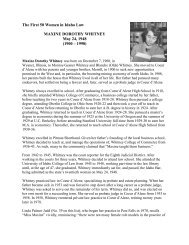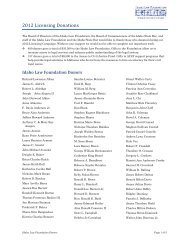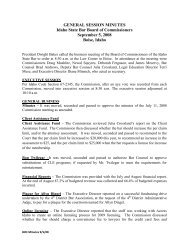The Advocate - May 2012 - Idaho State Bar - Idaho.gov
The Advocate - May 2012 - Idaho State Bar - Idaho.gov
The Advocate - May 2012 - Idaho State Bar - Idaho.gov
Create successful ePaper yourself
Turn your PDF publications into a flip-book with our unique Google optimized e-Paper software.
HOA restrictions on sex<br />
offender residence locations<br />
<strong>The</strong>re is no known <strong>Idaho</strong> case law<br />
interpreting a private <strong>gov</strong>erning association’s<br />
CC&Rs, Bylaws, or Rules and<br />
Regulations on the validity of sex offender<br />
residence location restrictions. A<br />
homeowners association may be a collection<br />
of single family detached residences<br />
or a condominium association. Usually,<br />
condominiums are located within a single<br />
building, like apartments, and so the<br />
<strong>gov</strong>erning board should consider whether<br />
sex offender residence restrictions will be<br />
reasonable or practical in condominiums.<br />
Conversely, in single family detached<br />
housing neighborhoods, restrictions may<br />
be practical and enforceable. Further, due<br />
to the health and safety aspects of such<br />
restrictions, a seniors-only community or<br />
one with a large number of young families<br />
may find such restrictions very desirable<br />
as a component of CC&Rs designed to<br />
elevate and maintain property values. A<br />
<strong>gov</strong>erning board should consider several<br />
components to such restrictions.<br />
Practice<br />
Tip<br />
Components of an HOA’s rule<br />
should include a policy justification,<br />
a list of applicable defi-<br />
nitions that blend with definitions used in<br />
the other <strong>gov</strong>erning documents such as<br />
landlord-tenant provisions, distance requirements,<br />
and notice and approval processing<br />
requirements. Generally, as in all<br />
such enactments, the new rules must work<br />
with the old rules.<br />
Minimum distance requirements<br />
should be considered, because the law<br />
recognizes that when several convicted<br />
sex offenders live together or near places<br />
where children are found, such as schools,<br />
restrictions are proper. 30 <strong>Idaho</strong> cities and<br />
counties may restrict sex offender group<br />
residence location by mandating “permissible<br />
distances between such houses.” 31<br />
<strong>The</strong>se distance restrictions should be arranged<br />
such that a grid is created, “to<br />
minimize [sex] offender clustering within<br />
a community.” 32<br />
Practice<br />
Tip<br />
Whether an HOA is responsible<br />
for facilities maintenance<br />
or not, identification of either<br />
member or publicly used facilities within<br />
HOA territory should be mapped, including<br />
school bus stop locations, parks, clubhouses,<br />
pools, exercise areas, etc., because<br />
high use areas usually mean higher HOA<br />
expenditures for maintenance of HOAadjacent<br />
areas.<br />
Such a planned grid is used in some<br />
<strong>Idaho</strong> cities for specifying the location of<br />
30 <strong>The</strong> <strong>Advocate</strong> • <strong>May</strong> <strong>2012</strong><br />
Local private covenants may<br />
be preferred over zoning rules,<br />
because a homeowners association<br />
can accomplish this task with<br />
nothing but a good map.<br />
sex-oriented businesses, and there is no<br />
reason such zoned use criteria cannot be<br />
contractually used in privately <strong>gov</strong>erned<br />
associations. 33 Governing boards should<br />
include how a distance restriction is to<br />
be calculated, whether it be air miles (as<br />
the crow flies), or other measure, so that<br />
owners and prospective tenants may do<br />
their own calculations before applying to<br />
a board for occupancy.<br />
Practice<br />
Tip<br />
Distance restrictions should be<br />
calculated and applied equally,<br />
whether the convicted sex of-<br />
fender lives within or outside the development.<br />
<strong>The</strong> fact of a convicted sex offender<br />
living one block outside the subdivision<br />
will impact homes in the subdivision, if<br />
the planning grid radius is more than one<br />
block long.<br />
Associations contemplating such restrictions<br />
should also consider homeowners<br />
and renters. Usually, CC&Rs require<br />
landlords to give prospective tenants a<br />
copy of the <strong>gov</strong>erning documents, and<br />
tenants are required to adhere to them. In<br />
every case, the potential landlord subject<br />
to such restrictions would be responsible<br />
for determining whether prospective tenants<br />
could be allowed at a particular residence<br />
location. <strong>The</strong> association restrictions<br />
need to either allow for a time delay<br />
during implementation for existing owners<br />
and leasehold tenants with vested rights to<br />
move, or allow temporary waivers where<br />
hardship may result. Also, tenants need<br />
to know whether and where they may<br />
move into an association’s territory, so<br />
the <strong>gov</strong>erning board should track sex offender<br />
residential locations within its area<br />
of <strong>gov</strong>ernance, and be prepared to share<br />
the most current knowledge it has related<br />
to convicted sex offender residential locations,<br />
or direct owners to the <strong>Idaho</strong> Sex<br />
Offender Registration (ISOR) website. 34<br />
Practice<br />
Tip<br />
HOA legal counsel should<br />
recommend identification of<br />
all non-owner occupied hous-<br />
ing and make sure the HOA has copies of<br />
leases that mandate tenants abide by HOA<br />
<strong>gov</strong>erning documents. <strong>The</strong>y should additionally<br />
recommend a newsletter or website<br />
to keep landlords apprised of HOA<br />
requirements regarding leased properties,<br />
including any required process and time<br />
frames related to restrictions on convicted<br />
sex offender residence locations. Good<br />
planning and communication can help<br />
avoid or mitigate most complaints about<br />
HOA policies.<br />
Potential issues<br />
<strong>The</strong> criteria cited above require an<br />
active association <strong>gov</strong>erning board, because<br />
“not only are offenders required to<br />
maintain an awareness of what housing<br />
stock is available outside the [restricted<br />
zone], they must also be cognizant of<br />
where other offenders have established a<br />
permanent residence in an effort to adhere<br />
to the hybrid restrictions that may<br />
be in place . . . [thus,] without advanced<br />
analytical and modeling approaches combined<br />
with detailed spatial information,<br />
the contingencies of these hybrid strategies<br />
are difficult to identify, especially<br />
for offenders, landlords, law enforcement<br />
agencies, and correction officials.” 35 This<br />
is a good example of where local private<br />
covenants may be preferred over zoning<br />
rules, because a homeowners association<br />
can accomplish this task with nothing but<br />
a good map.<br />
An active <strong>gov</strong>erning board may have<br />
little trouble with these criteria. However,<br />
even with accurate records, a private association<br />
board may draw unnecessary<br />
lawsuits from tenants denied housing, or<br />
from the landlord or owner who may not<br />
live in their own home, even where civil<br />
liability is barred based on public registration<br />
records, (see below). <strong>The</strong>se claims<br />
will likely fail if the board made a good<br />
faith effort to create the rules and if the<br />
board has a solid process to determine









